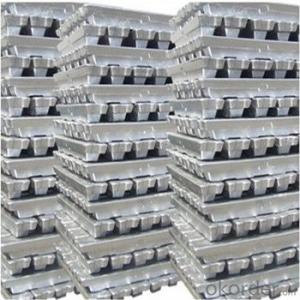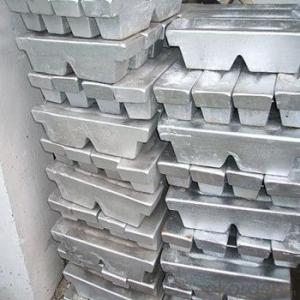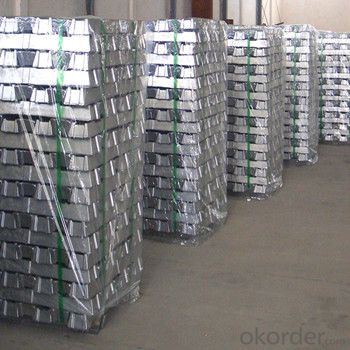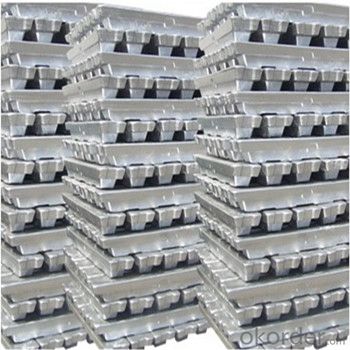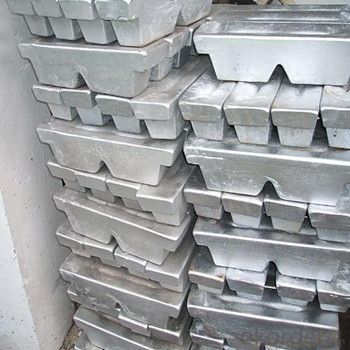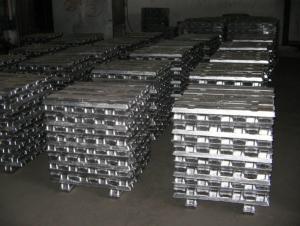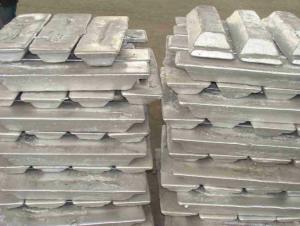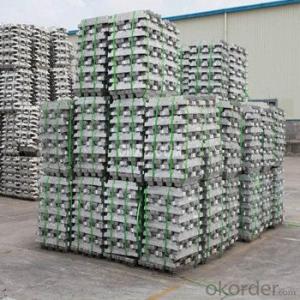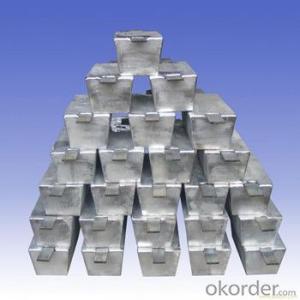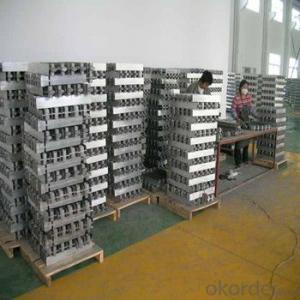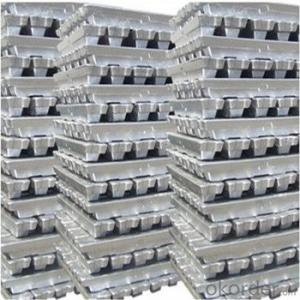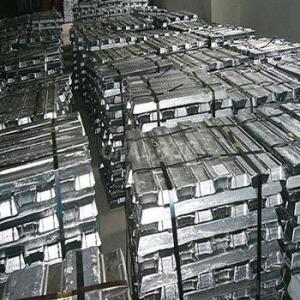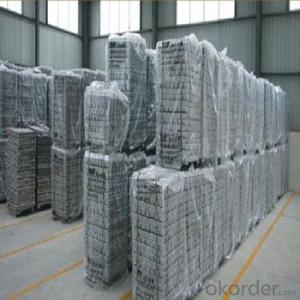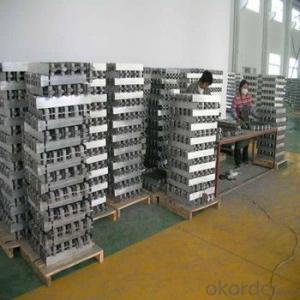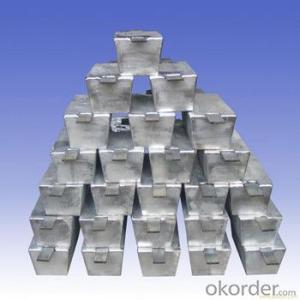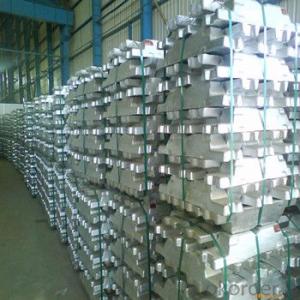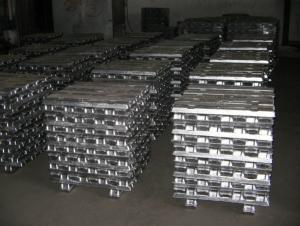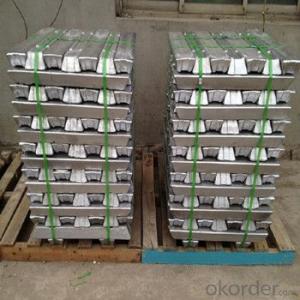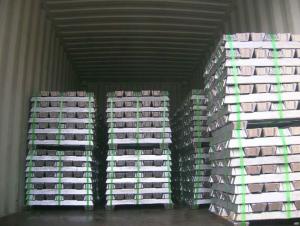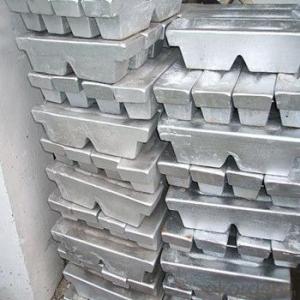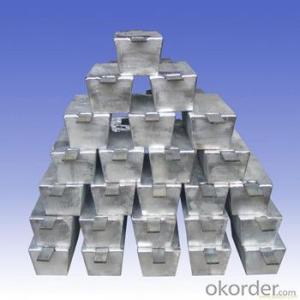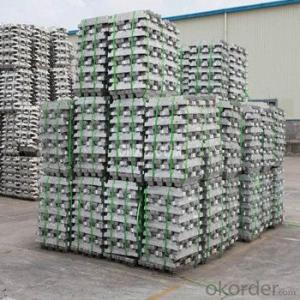Aluminum Pig/Ingot With Wholesale Price From Mill
- Loading Port:
- China main port
- Payment Terms:
- TT OR LC
- Min Order Qty:
- 1000 m.t.
- Supply Capability:
- 100000 m.t./month
OKorder Service Pledge
OKorder Financial Service
You Might Also Like
Pure Aluminum Pig/Ingot Used for Industry
1.Structure of Aluminum Pig/Ingot
A material that has been cast into a shape in order to be transported and processed easier than in an unprocessed form. An ingot is typically rectangular in shape, which allows it to be stacked. Ingots are most commonly associated with metals, with ingots of gold held in the vaults of banks and brokerages being popular images.
Aluminum Ingot is with the AL as the main chemical composition.Aluminum Ingot is used for industry,such as automobile,pinning and weaving,electron broadly and so on. Aluminum Ingot has the following advantages: easy control and operation, fast melting.
2.Main Features of the Aluminum Pig/Ingot
•High Purity
•Easy control and operation
•High strength
•Fast melting
•Competitive price
•Best Service
3.Aluminum Pig/Ingot Images
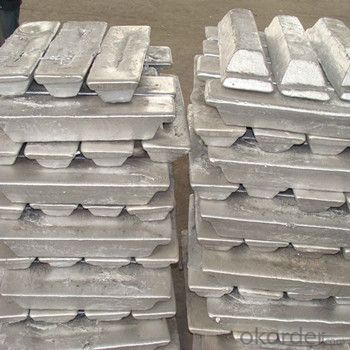
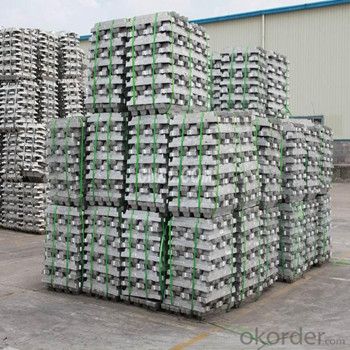
4.Aluminum Pig/Ingot Specification
Grade | Chemical Composition % | |||||||||
Al≥ | impurities ≤ | |||||||||
Si | Fe | Cu | Ga | Mg | Zn | Mn | others | Sum | ||
Al99.9 | 99.90 | 0.50 | 0.07 | 0.005 | 0.02 | 0.01 | 0.025 | - | 0.010 | 0.10 |
Al99.85 | 99.85 | 0.80 | 0.12 | 0.005 | 0.03 | 0.02 | 0.030 | - | 0.015 | 0.15 |
Al99.7 | 99.70 | 0.10 | 0.20 | 0.010 | 0.03 | 0.02 | 0.030 | - | 0.030 | 0.30 |
Al99.6 | 99.60 | 0.16 | 0.25 | 0.010 | 0.03 | 0.03 | 0.030 | - | 0.030 | 0.40 |
Al99.5 | 99.50 | 0.22 | 0.30 | 0.020 | 0.03 | 0.05 | 0.050 | - | 0.030 | 0.50 |
Al99.00 | 99.00 | 0.42 | 0.50 | 0.020 | 0.03 | 0.05 | 0.050 | - | 0.050 | 1.00 |
5.FAQ of Aluminum Pig/Ingot
We have organized several common questions for our clients,may help you sincerely:
①How about your company?
A big and famous and professional manufacturer & supplier of Aluminum Pig/Ingot, is one of the one of the large-scale professional investment Aluminum Pig/Ingot production bases in China.It have focuses on producing the Aluminum Pig/Ingot production for many years and gotten rich experience.Annually lagrge amount of Aluminum Pig/Ingot production are exported to markets in Europe,America and Japan. The quality and service have also gotten OEM service is available according to customer’s requirements.
②How to guarantee the quality of the products?
We have established the international advanced quality management system,every link from raw material to final product we have strict quality test;We resolutely put an end to unqualified products flowing into the market. At the same time, we will provide necessary follow-up service assurance.
③How long can we receive the product after purchase?
In the purchase of product within three wo We have organized several common questions for our clients,may help you sincerely:
①How about your company?
A big and famous and professional manufacturer & supplier of Aluminum Pig/Ingot, is one of the one of the large-scale professional investment Aluminum Pig/Ingot production bases in China.It have focuses on producing the Aluminum Pig/Ingot production for many years and gotten rich experience.Annually lagrge amount of Aluminum Pig/Ingot production are exported to markets in Europe,America and Japan. The quality and service have also gotten OEM service is available according to customer’s requirements.
②How to guarantee the quality of the products?
We have established the international advanced quality management system,every link from raw material to final product we have strict quality test;We resolutely put an end to unqualified products flowing into the market. At the same time, we will provide necessary follow-up service assurance.
③How long can we receive the prod rking days, We will arrange the factory delivery as soon as possible. The pecific time of receiving is related to the state and position of customers.Commonly 7 to 10 working days can be served.
- Q: What are the different welding methods for aluminum ingots?
- There are several welding methods that can be used for aluminum ingots, including Tungsten Inert Gas (TIG) welding, Metal Inert Gas (MIG) welding, and oxyacetylene welding. TIG welding is commonly used for its precision and control, while MIG welding offers faster and more efficient welding. Oxyacetylene welding, on the other hand, is an older method that uses a flame to heat and melt the aluminum. Each method has its own advantages and is chosen based on the specific requirements of the project.
- Q: What are the basic equipments for the production of aluminium ingots?
- The most basic configuration: aluminum melting furnace, spectrum analyzer, forklift, loadometer, refining machine, casting machine is standard, if you really want to buy Artificial ingot casting province.
- Q: How do aluminum ingots contribute to the overall aluminum industry?
- Aluminum ingots play a crucial role in the overall aluminum industry as they serve as the primary raw material for the production of various aluminum products. Ingots are formed by smelting aluminum ore and then pouring the molten metal into molds to solidify. One significant contribution of aluminum ingots is their versatility. They can be further processed and shaped into different forms, such as sheets, plates, rods, tubes, and extrusions, which are used in a wide range of industries. These include automotive, aerospace, construction, packaging, electrical, and consumer goods sectors. Furthermore, aluminum ingots offer several advantages that contribute to the growth and sustainability of the aluminum industry. Aluminum is lightweight, corrosion-resistant, and possesses excellent conductivity, making it an ideal choice for many applications. Its low density allows for energy efficiency in transportation, reducing fuel consumption and emissions in the automotive and aviation sectors. Additionally, aluminum's corrosion resistance ensures longer-lasting products, reducing maintenance and replacement costs. The availability and affordability of aluminum ingots also contribute to the overall aluminum industry. Aluminum is the third most abundant element on Earth's crust and can be easily extracted from bauxite ore. This accessibility, combined with efficient production processes, makes aluminum ingots readily available for manufacturers at competitive prices, stimulating demand and market growth. Moreover, the recycling potential of aluminum ingots plays a significant role in the sustainability of the aluminum industry. Aluminum is infinitely recyclable, meaning it can be melted and reused without any loss in quality. Recycling aluminum requires only a fraction of the energy compared to primary production, resulting in significant energy savings and reduced environmental impact. The use of recycled aluminum ingots helps in conserving natural resources, reducing waste, and lowering carbon emissions. In conclusion, aluminum ingots are essential to the overall aluminum industry as they provide the raw material that is processed into a wide variety of aluminum products. Their versatility, lightweight nature, corrosion resistance, and recyclability make them highly valuable for multiple industries. The availability and affordability of aluminum ingots further contribute to the growth and sustainability of the aluminum industry, while their recycling potential helps in conserving resources and reducing environmental impact.
- Q: How are aluminum ingots used in the production of decorative items?
- Aluminum ingots are used in the production of decorative items as they can be easily molded, shaped, and cast into various designs. These ingots are melted down and poured into molds to create intricate patterns, textures, and forms, which can then be further processed, polished, and finished to produce a wide range of decorative items such as sculptures, ornaments, jewelry, and architectural accents. The lightweight nature and corrosion-resistant properties of aluminum make it a popular choice for creating aesthetically pleasing and long-lasting decorative pieces.
- Q: What elements do alloy die casting ingots require?
- Silicon is the major element in most die cast aluminum alloys. It can improve the casting properties of alloys. Silicon and aluminum can form solid solutions. At 577 DEG C, the solubility of silicon in aluminium is 1.65%, at room temperature is 0.2%, and when silicon content is up to 11.7%, silicon and aluminum form eutectic. Improve the high temperature molding properties of the alloy, reduce shrinkage, no hot cracking tendency. Two element aluminum base alloy has high corrosion resistance. When the content of silicon in the alloy exceeds the eutectic component, and the impurities such as copper and iron are long, the hard point of free silicon appears, which makes the machining difficult. The corrosion of the cast silicon crucible by high silicon aluminum alloy is serious.
- Q: What is the role of aluminum ingots in the production of cans?
- The production of cans relies heavily on aluminum ingots, which serve as the primary raw material in the manufacturing process. These ingots are melted and then shaped into the desired size and form of the can. Aluminum is the chosen material for cans due to its exceptional properties. Its lightweight nature makes transportation and handling easier. Additionally, it is highly durable and resistant to corrosion, ensuring the cans effectively safeguard their contents. After the aluminum ingots are melted and shaped, they undergo several processes to transform into the final can. This involves shaping, forming, and coating to ensure strength and withstand the pressure exerted by carbonated beverages. Moreover, aluminum ingots enable convenient recycling of cans. Aluminum is a highly recyclable material, and incorporating ingots in the production process guarantees that cans can be recycled and reused multiple times without compromising quality. In conclusion, aluminum ingots play a crucial role in can production, providing the essential raw material for lightweight, durable, and recyclable containers extensively used in the beverage industry.
- Q: What is the aluminum ingot smelting
- Concrete method: heating to melt state, through a variety of physical and chemical methods, last year after impurities, made of various grades of aluminum, pouring into aluminum ingot.
- Q: How can the pop top smelting be purified after the aluminium ingot is smelted?Then sell aluminum ingot raw material suitable?
- Because the cans of printing, transportation, recycling process, there will be a lot of impurities, so to purify
- Q: Is it harmful to the human body to refine ingots from waste capacitors?
- The electrolyte here, not the electrolyte in the battery, must be made clear;
- Q: How are aluminum ingots shaped into different forms?
- Aluminum ingots are shaped into different forms through a process called aluminum extrusion. This process involves heating the aluminum ingot until it reaches a molten state. The molten aluminum is then forced through a specifically designed die, which determines the shape and size of the final product. The die is a hollow profile with the desired shape, and it acts as a mold for the molten aluminum. Once the molten aluminum passes through the die, it undergoes a cooling process, which solidifies it into the desired shape. The cooling process can be done through various methods, including air cooling or water quenching. The method used depends on the specific requirements of the product. After the aluminum has cooled and solidified, it is then cut into the desired length. This can be done either during or after the extrusion process, depending on the complexity of the shape or the requirements of the product. Aluminum extrusion allows for a wide range of shapes to be produced, including solid profiles, hollow sections, tubes, and intricate designs. The process is highly versatile and efficient, making it a popular choice for shaping aluminum into different forms. Additionally, the lightweight and corrosion-resistant properties of aluminum make it an ideal material for a variety of applications, from construction and automotive industries to consumer goods and electronics.
Send your message to us
Aluminum Pig/Ingot With Wholesale Price From Mill
- Loading Port:
- China main port
- Payment Terms:
- TT OR LC
- Min Order Qty:
- 1000 m.t.
- Supply Capability:
- 100000 m.t./month
OKorder Service Pledge
OKorder Financial Service
Similar products
Hot products
Hot Searches

